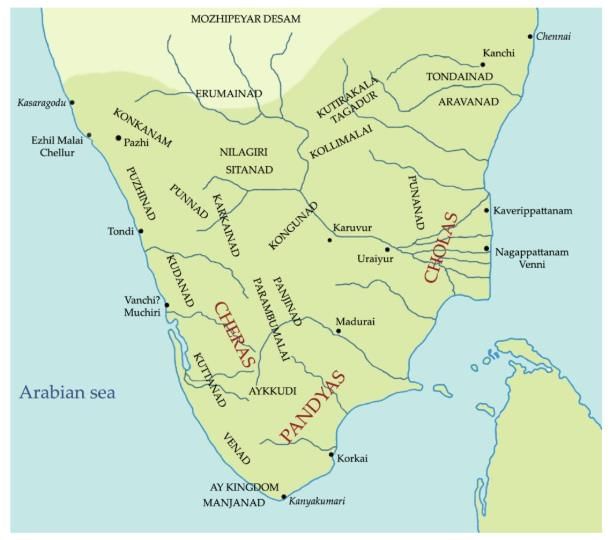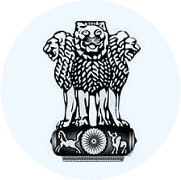UPSC Exam > UPSC Notes > History for UPSC CSE > Economic Condition, Social Life & Religion: The Sangam Age
Economic Condition, Social Life & Religion: The Sangam Age | History for UPSC CSE PDF Download
Economic Condition
- The majority of people were engaged in professions such as farming, cowherding, hunting, and fishing. During this period, industrial activities flourished.
- Industries like textiles, construction, jewellery making, and chariot manufacturing were essential for meeting basic needs and providing comforts and luxuries.
- Shipbuilding and harbour construction were also advanced. After agriculture, shipping and weaving were among the most important crafts.
- Trade was primarily conducted through barter, with paddy being the most commonly accepted medium of exchange.
- Markets, called angadi, were established in larger towns, with the marketplace referred to as avanam.
- Agriculture was practised across the region, especially in the delta area, with paddy as the main crop, supported by millets and other types of corn.
- The region engaged in extensive trade with foreign countries from ancient times, exporting items like pepper, ginger, rice, sandalwood, cardamom, cinnamon, ivory, and pearls.
- The discovery of large quantities of Roman gold coins in South India suggests active trade between Tamil Nadu and Rome.
- Major towns such as Puhar, Uraiyur, Vanji, Tondi, Muziris, Madurai, and Kanchi were key centers for manufactured goods, with manufacturers and traders present.
- A song from the Purananuru describes the sale of fish for paddy, bales of pepper, and the transport of goods in small boats from larger ships to the shore.
- Tuticorin or Korkai was famous for its pearls, Kodumanam for rare jewels, and the hills of the Chera country for abundant quartzite precious stones.
- Nirpeyarru was a seaport where horses and other goods were imported from the west and north, respectively.
- Panik Kalari was a significant factory for manufacturing and repairing weapons.
- Goods arriving at the port of Puhar included war-horses, bags of black pepper, gems, gold, sandal and agil woods, pearls, coral, food from Sri Lanka, and luxuries from Kadaram.
- External trade linked South India with the Hellenistic kingdoms of Egypt and Arabia, as well as Malaya, with later significance in Roman trade. Roman settlements and gold coins have been found at Muziris, Puhar or Kaveripattinam, and Arikamedu.
- Exports included cotton goods, pepper, ginger, cinnamon, turmeric, ivory, rice, cardamom, pearls, and precious stones, while main imports were horses and gold.
 Map of Sangam Period
Map of Sangam Period
Question for Economic Condition, Social Life & Religion: The Sangam AgeTry yourself: Which industries were important during the Sangam Age?View Solution
Social Life
- People lived in occupational groups, organised by their jobs, with a strong sense of community. They lived separately but close within each village or town.
- In addition to farmers, who were the most important part of society, there were other communities like fishermen, blacksmiths, carpenters, weavers, and cobblers.
- Sangam social life was not controlled by priests, even though Brahmanas were an important part of Vedic society.
- The term Chetti, referring to a trading community in South India, was known during the Sangam period. Tolkappiyar called them vaisigas.
- Women generally had a low status; widows had to shave their heads, give up all jewellery, and eat only basic food.
- Sati was fairly common but not universal, varying widely by region. There was a strong belief in omens and astrology.
- The banyan tree was considered sacred as a home for the gods. Poetry, music, and dance were the main forms of entertainment for the upper classes.
- Yal was a famous instrument, which was a stringed instrument like the lute.
- Both cremation with and without urns were common practices for disposing of the dead.
- Caste divisions and tribal structures existed together. The regular presence of Brahmanas as a varna was noted.
- The merchant community, known as Vaisigas by Tolkappiyar, was mainly found in towns. There was no regular presence of Kshatriya and Vaishya varnas.
- Velalas, known as agriculturists, were a very important part of society.
- The ruling class was called the ‘ Arasar ’. Minor groups included the “Kadaisiyar” (agricultural labourers) and ‘Pulaiyans’ (rope-makers).
- A detailed description of a padini, a singing woman from the panar caste, is found in the Perunanutruppadai, where Karikalan is portrayed as a master of seven notes.
- Various types of lutes, including Periyal, Palai-yal, and Sengottiyal, are described in detail.
- The dances of Viralis (professional dancing girls) were performed at night.
- Tolkappiyam and the Kalaviyal mention that the Aryans introduced marriage rituals (Karanam). These texts also refer to spontaneous unions (Kamak-Kuttam) and differentiate between secret marriages (Kalavu) and open ones agreed upon by parents (Karpu).
- Tolkappiyam and Kalaviyal refer to eight forms of marriage known in the Sanskrit Dharmasastras. While the gandharva form of marriage is easily linked to kalavu, the other Aryan forms are less clear.
Question for Economic Condition, Social Life & Religion: The Sangam AgeTry yourself:What was the term for the trading community in South India during the Sangam period?View Solution
Religion
- Religion was associated with rituals and a certain amount of metaphysical thoughts. Their rituals were related to animism and other forms of anthropomorphic deity worship.
- The hunters of the hill tracts worshipped Murugan as the God of the hillock. Indra, the God of Marudam, was worshipped by the agriculturists.
- The fishermen and the people of the coastal regions worshipped Varuna. Korravai was the God of victory.
- The name for temple nagar, kottam, purai, koli was mentioned in Tamil literature.
- The Vedic religion had struck root in the South. This is established by references to the costly sacrifices performed by monarchs of the age.
- The popularity and prevalence of the Brahmanical velvi (yajna), the sraddha and pinda to the dead, fasting etc. are well attested to by the Sangam literature.
- Rice mixed with flesh was offered to crows daily on the thresholds of houses.
- Vishnu sleeping on the coils of Ananta in Kanchipuram is mentioned in the Perumbanarruppadai.
- Siva as Ardhanarisvara, his bull Nandi, and his ganas are found together in the invocatory verse of the Purananuru.
- Gods on the basis of caste are mentioned in the Silappadikaram. Brahmana, the thirty-three devas, and the eleven ganas are mentioned in Tirumururruopadai.
- The temple of Indra is mentioned in Silappadikaram and in Manimekalai. Vilakalol was the festival of Indra.
The document Economic Condition, Social Life & Religion: The Sangam Age | History for UPSC CSE is a part of the UPSC Course History for UPSC CSE.
All you need of UPSC at this link: UPSC
|
216 videos|855 docs|219 tests
|
FAQs on Economic Condition, Social Life & Religion: The Sangam Age - History for UPSC CSE
| 1. What were the main features of the economy during the Sangam Age? |  |
Ans. The economy during the Sangam Age was primarily agrarian, with agriculture being the mainstay of the economy. The fertile plains of Tamil Nadu supported the cultivation of rice, sugarcane, and other crops. Trade was also significant, with merchants engaging in both local and international trade, exporting goods such as spices, textiles, and pearls. The use of coins and a well-developed system of weights and measures facilitated commerce.
| 2. How did social life evolve during the Sangam Age? |  |
Ans. Social life in the Sangam Age was diverse and vibrant, characterized by a hierarchical society. The community was divided into various classes, including the ruling class (kings and chieftains), warriors, merchants, and farmers. Women played a significant role in society, often depicted in literature as strong and independent figures. Festivals and cultural events were common, fostering a sense of community and shared identity among the people.
| 3. What role did religion play in the Sangam Age? |  |
Ans. Religion during the Sangam Age was a blend of indigenous beliefs and later influences. The worship of nature, ancestors, and various deities was prevalent. The emergence of Shaivism and Vaishnavism marked the period, with temples becoming centers of worship and community life. The poets of the Sangam literature often expressed spiritual themes, reflecting the deep connection between religion and daily life.
| 4. What was the significance of Sangam literature in understanding this age? |  |
Ans. Sangam literature is crucial for understanding the cultural, social, and economic aspects of the Sangam Age. Composed by various poets, these texts provide insights into the values, beliefs, and daily experiences of people during this period. They also highlight the importance of patronage from kings and chieftains and serve as a historical record of the societal norms and practices of the time.
| 5. How did the political structure impact the social and economic conditions of the Sangam Age? |  |
Ans. The political structure during the Sangam Age was characterized by a system of small kingdoms ruled by chieftains and kings, which significantly influenced social and economic conditions. The support from rulers fostered trade and agriculture, while their patronage of arts and literature led to a flourishing cultural environment. However, constant conflicts between these kingdoms also affected trade routes and agricultural stability, reflecting the interdependence of politics with social and economic life.
Related Searches






















